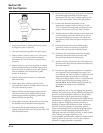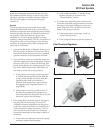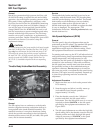
5B.18
Section 5B
EFI Fuel System
Spark Plugs
EFI engines are equipped with Champion
®
RC12YC
(Kohler Part No. 12 132 02-S) resistor spark plugs.
Equivalent alternate brand plugs can also be used, but
must be resistor plugs or permanent damage to the
ECU will occur, in addition to affecting operation.
Proper spark plug gap is 0.76 mm (0.030 in.).
Wiring Harness
The wiring harness used in the EFI system connects
the electrical components, providing current and
ground paths for the system to operate. All input and
output signaling occurs through a special all weather
connector that attaches and locks to the ECU (see
Figures 5B-21 and 5B-22).
The condition of the wiring, connectors, and terminal
connections is essential to system function and
performance. Corrosion, moisture, and poor
connections are more likely the cause of operating
problems and system errors than an actual
component. Refer to the ‘‘Troubleshooting –
Electrical’’ section for additional information.
Battery Charging System
EFI engines are equipped with either a 15 or 25 amp
charging system to accommodate the combined
electrical demands of the ignition system and the
specific application. Charging system troubleshooting
information is provided in Section 8.
Fuel Components
Fuel Pump
Internal
External
Figure 5B-21. “24 Pin” (MSE 1.0) Plastic-Cased
ECU Connector.
Figure 5B-22. “32 Pin” (MSE 1.1) Plastic-Cased
ECU Connector.
Figure 5B-23. Fuel Pump Styles.
General
An electric fuel pump is used to transfer fuel in the
EFI system. Depending on the application, the pump
may be inside the fuel tank, or in the fuel line near the
tank. The pumps are rated for a minimum output of
25 liters per hour at 39 psi. The pumps have an
internal 60-micron filter. In addition, the in-tank style
pumps will have a pre-filter attached to the inlet. In-
line pump systems may also have a filter between the
tank and the pump on the pickup/low pressure side.
The final fuel filter is covered separately on page
5B-21.
When the key switch is turned “on” and all safety
switch requirements are met, the ECU, through the
relay activates the fuel pump, which pressurizes the
system for start-up. If the key switch is not promptly
turned to the “start” position, the engine fails to start,
or the engine is stopped with the key switch “on” (as
in the case of an accident), the ECU switches off the


















